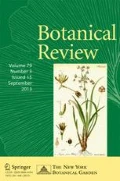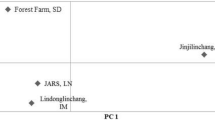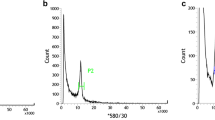Abstract
Yellow horn (Xanthoceras sorbifolia bunge) is a small endemic oilseed energy plant native to the northern part of China, which can survive in desert, semi-arid and arid environment, and therefore has important economic, environmental and ecological value for biodiesel production, agricultural production and ecological restoration. With the increased concerns on the energy shortage and ecological environment change, yellow horn has won worldwide attention in recent years. However, the systematic molecular analysis of yellow horn using the advanced molecular biological techniques still remain limited. Considering this, we summarized the recent advances in the investigations of yellow horn at molecular level and discussed the future research directions and prospects. This review would provide guidance and open new horizons towards the futuristic development and prospects for further exploitation and utilization of yellow horn.



Similar content being viewed by others
References
An C, Lee H, Lee J, Cheong EJ, Li Y, and Yi J-S. 2016. Analysis of genetic diversity and differentiation of artificial populations of yellowhorn (Xanthoceras sorbifolium) in China using ISSR markers. Journal of forestry research. 27:1099-1104.
Andersen JR, and Lübberstedt T. 2003. Functional markers in plants. Trends in plant science. 8:554-560.
Ao Y, Ma LY, Han SW, Yang X, and Han SW. 2015. Transcriptome Analysis for Xanthoceras sorbifolia Bunge Based on High-throughput Sequencing Technology. China Biotechnology. 35:22-29.
Ao Y, Wang Y, Chen L, Wang T, Yu H, and Zhang Z. 2012. Identification and comparative profiling of microRNAs in wild-type Xanthoceras sorbifolia and its double flower mutant. Genes & Genomics. 34:561-568.
Ao Y, Zhao L, Jiang C, and Ma L. 2014. Analysis on Differential Expression of MicroRNAs in Different Types of Xanthoceras sorbifolia. Acta Agriculturae Boreali-Simica. 29 16-22.
Ao Y, 2010. Type classification, individual selection and relevant studies on woody energy plant Xanthoceras sorbifolia Bunge. Chinese Academy of Forestry.
Bertani G, Sardaro MLS, Neviani E, and Lazzi C. 2019. AFLP protocol comparison for microbial diversity fingerprinting. Journal of applied genetics. 60:217-223.
Bi Q, and Guan W. 2014. Isolation and characterisation of polymorphic genomic SSRs markers for the endangered tree Xanthoceras sorbifolium Bunge. Conservation genetics resources. 6:895-898.
Bi Q, Guo B, Zhang D, and Guan W. 2015a. Identification and characterization of conserved and novel microRNAs in Xanthoceras sorbifolium via deep sequencing. Genes & Genomics. 37:281-286.
Bi Q, Mao J-F, and Guan W. 2015b. Efficiently developing a large set of polymorphic EST-SSR markers for Xanthoceras sorbifolium by mining raw reads from high-throughput sequencing. Conservation Genetics Resource.s 7:423-425.
Bi Q, Zhao Y, Du W, Lu Y, Gui L, Zheng Z, Yu H, Cui Y, Liu Z, and Cui T. 2019a. Pseudomolecule-level assembly of the Chinese oil tree yellowhorn (Xanthoceras sorbifolium) genome. Gigascience. 8:giz070.
Bi Q, Zhao Y, Cui YF, and Wang LB. 2019b. Genome survey sequencing and genetic background characterization of yellow horn based on next-generation sequencing. Molecular Biology Reports. 46:4303-4312.
Bornet B, and Branchard M. 2001. Nonanchored inter simple sequence repeat (ISSR) markers: reproducible and specific tools for genome fingerprinting. Plant molecular biology reporter 19:209-215.
Cai Y, Yu X, Hu S, and Yu J. 2009. A brief review on the mechanisms of miRNA regulation. Genomics, proteomics & bioinformatics. 7:147-154.
Chang QY, Lu X, Liu Z, Zheng ZM, and Yu S. 2020. Identification and characterization of the bZIP transcription factor family in yellowhorn. Journal Of Forestry Research. https://doi.org/10.1007/s11676-020-01129-3
Cheng Y-Q, Wang H-W, Wan H-X, Duan J-M, Zhang P, and Han W-L. 2013. Construction and characterization of enriched microsatellite library from Xanthoceras sorbifolia [J]. Journal of Henan Agricultural University. 4:440-445.
Dong X, Ruan C, Liu L, Yan R, and Han P. 2019. Development of SSR Markers for target genes in Xanthoceras sorbifolia based on high throughput RNA-seq technology. Molecular Plant Breeding.17:2943-2949.
Du X. 2003. Study on Molecular Mechanism of Male Sterility in Xanthoceras sorbifolia Bunge. Beijing Forestry University.
Du X, Lu H, and Li F. 2003. Cloning and sequencing of cDNAs associated with male-fertility in Xanthoceras sorbifolia Bunge. Journal of Beijing Forestry University. 25:29-33.
El-Kassaby YA, Wang Q, Wang T, Ratcliffe B, Bi Q-X, Wang Z, Mao J-F, and Guan W. 2019. Concept for gene conservation strategy for the endangered Chinese yellowhorn, Xanthoceras sorbifolium, based on simulation of pairwise kinship coefficients. Forest Ecology And Management. 432:976-982.
Fan C. 2009. Molecular cloning and preliminary analysis of pistil aborted associated genes in male flowers of Xanthoceras sorbifolia Bunge. Beijing Forestry University
Gu Y. 2005. Mechanisms of somatic embryogenesis and morphogenesis of Xanthoceras sorbifolia bunge. Beijing Forestry University.
Gu Y, Gao S, Li F, Hu Q, and Wang Y. 2011. Variation in protein expression during somatic embryogenesis of Xanthoceras sorbifolia. Scientia Silvae Sinicae. 47:53-57.
Guan L-P, Yang T, Li N, Li B-S, and Lu H. 2010. Identification of superior clones by RAPD technology in Xanthoceras sorbifolia Binge. Forestry Studies in China 12:37-40.
Guo D. 2013. Study on the regularity of the blooming and seed bearing of superior type and the construction of RAPD fingerprint of Xanthoceras sorbifoli. Northwest A&F University.
Guo H-H, Wang T-T, Li Q-Q, Zhao N, Zhang Y, Liu D, Hu Q, and Li F-L. 2013. Two novel diacylglycerol acyltransferase genes from Xanthoceras sorbifolia are responsible for its seed oil content. Gene. 527:266-274.
Guo HH, Li QQ, Wang TT, Hu Q, Deng WH, Xia XL, and Gao HB. 2014. XsFAD2 gene encodes the enzyme responsible for the high linoleic acid content in oil accumulated in Xanthoceras sorbifolia seeds. Journal Of The Science Of Food And Agriculture. 94:482-488.
Hadrys H, Balick M, and Schierwater B. 1992. Applications of random amplified polymorphic DNA (RAPD) in molecular ecology. Molecular ecology. 1:55-63.
Lang Y and Liu Z. 2020. Basic Helix-Loop-Helix (bHLH) transcription factor family in yellow horn (Xanthoceras sorbifolia Bunge): Genome-wide characterization, chromosome location, phylogeny, structures and expression patterns. International Journal Of Biological Macromolecules. 160:711-723.
Lang Y, Liu Z, and Zheng Z. 2020. Investigation of yellow horn (Xanthoceras sorbifolia Bunge) transcriptome in response to different abiotic stresses: a comparative RNA-Seq study. Rsc Advances. 10: 6512-6519
Li J, Fu Y-J, Qu X-J, Wang W, Luo M, Zhao C-J, and Zu Y-G. 2012. Biodiesel production from yellow horn (Xanthoceras sorbifolia Bunge) seed oil using ion exchange resin as heterogeneous catalyst. Bioresource Technology. 108:112-118.
Li J, Luo M, Zhao C-J, Li C-Y, Wang W, Zu Y-G, and Fu Y-J. 2013. Oil removal from water with yellow horn shell residues treated by ionic liquid. Bioresource technology. 128:673-678.
Liang Q, Li H, Li S, Yuan F, Sun J, Duan Q, Li Q, Zhang R, Sang YL, and Wang N. 2019. The genome assembly and annotation of yellowhorn (Xanthoceras sorbifolium Bunge). GigaScience. 8:giz071.
Liu L, Ruan C, Wang L, Wang W, Wang H, Wu B, and Yan R. 2018a. Coordinated Regulation of Multigenes Formed by Fatty Acids in Kernel Oil of Xanthoceras sorbifolium. Molecular Plant Breeding. 17:1834-1842.
Liu L, Ruan C, Wang L, Wang W, Wu B, and Yan R. 2018b. Coordinated Expression of Source and Sink Genes Involved in Lipid Biosynthesis and Accumulation During Kernel Development of Xanthoceras sorbifolium. Molecular Plant Breeding. 16: 6326-6331.
Liu X, Ji X, Lu L, Yang B, Wang L, and Zou L. 2007. Improvement of ethanol extract from husk of Xanthoceras sorbifolia on rats with learning and memory dysfunction. Chinese Traditional and Herbal Drugs. 38:1859-1863.
Liu X, Ma J, Luo Y, Li Z, and Wang L. 2018c. Full-length cDNA Sequence and Bioinformatics of APETALA2 gene from woody oil plant Xanthoceras sorbifolia. Modern Agricultural Science and Technology. 2:145-146.
Liu Y. 2013. Dynamic Analysis and Molecular Markers Development on genes related to oil biosynthesisand catabolism in yellow horn (Xanthoceras sorbifolia Bunge). Beijing Forestry University.
Liu Y, Huang Z, Ao Y, Li W, and Zhang Z. 2013. Transcriptome analysis of yellow horn (Xanthoceras sorbifolia Bunge): a potential oil-rich seed tree for biodiesel in China. Plos One 8:e74441.
Liu Z. 2012. Studies on different proteomic among thephases of adventitious rooting of xanthocerassorbifolia cuttings. Northwest Agriculture & Forestry University.
Liu Z, Saiyinduleng, Chang QY, Cheng CW, Zheng ZM, and Yu S. 2020 Identification of yellowhorn (Xanthoceras sorbifolium) WRKY transcription factor family and analysis of abiotic stress response model. Journal Of Forestry Research. https://doi.org/10.1007/s11676-020-01134-6
Liu Z J, Zhang S, Zhao Z, Zhang BY, and Zong JW. 2012. Optimization of Two-dimensional Gel Electrophoresis for Proteome from the Phloem of Xanthoceras sorbifolia. Journal of Northwest Forestry University. 27:55-61.
Lu M, Han S, Yang Q, Wang J, and Guo H. 2018. Cloning and expression analysis of LEC1 gene from Xanthoceras sorbifolia embryos. Journal of Beijing Forestry University. 40:8-16.
Ma K. 2004. Studies on male sterility-associated special proteins in Xanthoceras sorbifolia Bunge. Beijing Forestry University.
Ma K, Gao S, Hu Q, Cheng P, Wu J, and Li F. 2004. Anatomy of stamen and male sterility-associated proteins in Xanthoceras sorbifolia Bunge. Journal of Beijing Forestry University .26:40-42.
Ma Q, Li R-r, Ruan C, Li J, and Wang L. 2017. Analysis of XsFAE1 Gene Sequence of Xanthoceras sorbifolia and Prediction of Erucic Acid Mutation Site. Molecular Plant Breeding. 15:3913-3919.
Martin JA, and Wang Z. 2011. Next-generation transcriptome assembly. Nature Reviews Genetics. 12:671.
Metzker ML. 2010. Sequencing technologies-the next generation. Nature Reviews Genetics. 11:31.
Michlewski G, and Cáceres JF. 2019. Post-transcriptional control of miRNA biogenesis. Rna-A Publication Of The Rna Society. 25:1-16.
Mondini L, Noorani A, and Pagnotta MA. 2009. Assessing plant genetic diversity by molecular tools. Diversity. 1:19-35.
Mou H. 2006. Investigation and research on woody energy plant Xanthoceras sorbifolia Bunge. Chinese Academy of Forestry.
Nadeem MA, Nawaz MA, Shahid MQ, Doğan Y, Comertpay G, Yıldız M, Hatipoğlu R, Ahmad F, Alsaleh A, and Labhane N. 2018. DNA molecular markers in plant breeding: current status and recent advancements in genomic selection and genome editing. Biotechnology & Biotechnological Equipment. 32:261-285.
Powell W, Machray GC, and Provan J. 1996. Polymorphism revealed by simple sequence repeats. Trends in plant science. 1:215-222.
Qi Y, Ji X-F, Chi T-Y, Liu P, Jin G, Xu Q, Jiao Q, Wang L-H, and Zou L-B. 2018. Xanthoceraside attenuates amyloid β peptide1-42-induced memory impairments by reducing neuroinflammatory responses in mice. European Journal Of Pharmacology. 820:18-30.
Reddy MP, Sarla N, and Siddiq E. 2002. Inter simple sequence repeat (ISSR) polymorphism and its application in plant breeding. Euphytica. 128:9-17.
Ruan C-J, Yan R, Wang B-X, Mopper S, Guan W-K, and Zhang J. 2017. The importance of yellow horn (Xanthoceras sorbifolia) for restoration of arid habitats and production of bioactive seed oils. Ecological engineering. 99:504-512.
Shen Z, Zhang K, Ma L, Duan J, and Ao Y. 2017. Analysis of the genetic relationships and diversity among 11 populations of Xanthoceras sorbifolia using phenotypic and microsatellite marker data. Electronic Journal Of Biotechnology. 26:33-39.
Tangphatsornruang S, Uthaipaisanwong P, Sangsrakru D, Chanprasert J, Yoocha T, Jomchai N, and Tragoonrung S. 2011. Characterization of the complete chloroplast genome of Hevea brasiliensis reveals genome rearrangement, RNA editing sites and phylogenetic relationships. Gene 475:104-112.
Wang L-W, Wu S-Q, Kou Y-Y, and Luo G-J. 2012. RAPD analysis of germplasm resources of Xanthoceras sorbifolia Journal of Liaoning Forestry Science & Technology 1:11-12.
Wang L, Liu X, Ma J, Yuan L, and Li Z. 2018a. Expression of Genes Involved in Biosynthesis and Accumulation of Nervonic Acid during Seed Development in Xanthoceras Sorbifolium Bunge. Hubei Agricultural Sciences 57:117-120.
Wang L, Ruan C, Liu L, Du W, and Bao A. 2018b. Comparative RNA-Seq Analysis of High-and Low-Oil Yellow Horn During Embryonic Development. International Journal Of Molecular Sciences. 19(10):3071.
Wang Q. 1999. Biochemical and physiological study on the mechanism of Xanthoceras sorbifolia Bunge's male sterility. Beijing Forestry University.
Wang W. 2015. Transcriptome analysis of the mechanisms of Xanthoceras sorbifolia seedings in response to low temperature. Shandong Agricultural University.
Wang X, Ao Y, Liu Y, Zhang N, Zheng Y, Liu J, Zhang X, and Zhang Y. 2019. Selection of Reference Genes for Quantitative Real-Time PCR in Xanthoceras sorbifolium Bunge. Molecular Plant Breeding.18(9):2977-2986.
Wulan B. 2015. Cloning and expression analysis of two key enzyme genes (FAE1 and FAD2) for fatty acid synthesis in Xanthoceras sorbifolia. Inner Mongolia University.
Yao Z-Y, Qi J-H, and Yin L-M. 2013. Biodiesel production from Xanthoceras sorbifolia in China: Opportunities and challenges. Renewable and Sustainable Energy Reviews. 24:57-65.
Yu H, Fan S, Bi Q, Wang S, Hu X, Chen M, and Wang L. 2017. Seed morphology, oil content and fatty acid composition variability assessment in yellow horn (Xanthoceras sorbifolium Bunge) germplasm for optimum biodiesel production. Industrial crops and products. 97:425-430.
Zhang M. 2012. Analysis of characters and construction of fingerprint of superior individual in Xanthoceras sorbifolia Bunge by RAPD. Northwest A&F University.
Zhang T, Ai J, Li L, Pan N, and Sun X. 2019. Full-length cDNA Sequence and Bioinformatics of Transcription Factor ABI3 from Xanthoceras sorbifolia. Modern Agricultural Science and Technology. 2:90-91
Zhao N, Zhang Y, Li Q-Q, Li R-F, and Guo H-H. 2015a. Sequence and functional analysis of FAD2 gene from Xanthoceras sorbifolia seeds. Journal of Beijing Forestry University.12(2):87-93
Zhao N, Zhang Y, Li Q, Li R, Xia X, Qin X, and Guo H. 2015b. Identification and expression of a stearoyl-ACP desaturase gene responsible for oleic acid accumulation in Xanthoceras sorbifolia seeds. Plant Physiology and Biochemistry. 87:9-16.
Zhao Y, Guo Y, and Lingyun Z. 2019. Transcriptome sequencing and analysis of Xanthoceras sorbifolia Bunge fruit. Biotechnology bulletin. 35:24-31.
Zhou QY, and Liu GS. 2012. The embryology of Xanthoceras and its phylogenetic implications. Plant Systematics And Evolution. 298:457-468.
Zhu S. 2000. Physiological mechanism and FPS cloning in flower bud of Xanthoceras sorbifolia Bunge. Beijing Forestry University.
Funding
This work was funded by the Fundamental Research Funds for the Chinese Central Universities (grant number 2572018AA28); National Natural Science Foundation of China (grant number 31901114, 31870486); Natural Science Foundation of Heilongjiang Province (grant number LH2019C039); Innovative Research Projects for Postgraduates of Harbin University of Commerce (YJSCX2018-484HSD).
Author information
Authors and Affiliations
Corresponding authors
Ethics declarations
Competing Interests
The authors declare there are no competing interest.
Electronic supplementary material
ESM 1
(XLSX 12 kb)
Rights and permissions
About this article
Cite this article
Lang, Y., Sun, Y., Feng, Y. et al. Recent Progress in the Molecular Investigations of Yellow Horn (Xanthoceras sorbifolia Bunge). Bot. Rev. 86, 136–148 (2020). https://doi.org/10.1007/s12229-020-09224-0
Published:
Issue Date:
DOI: https://doi.org/10.1007/s12229-020-09224-0




